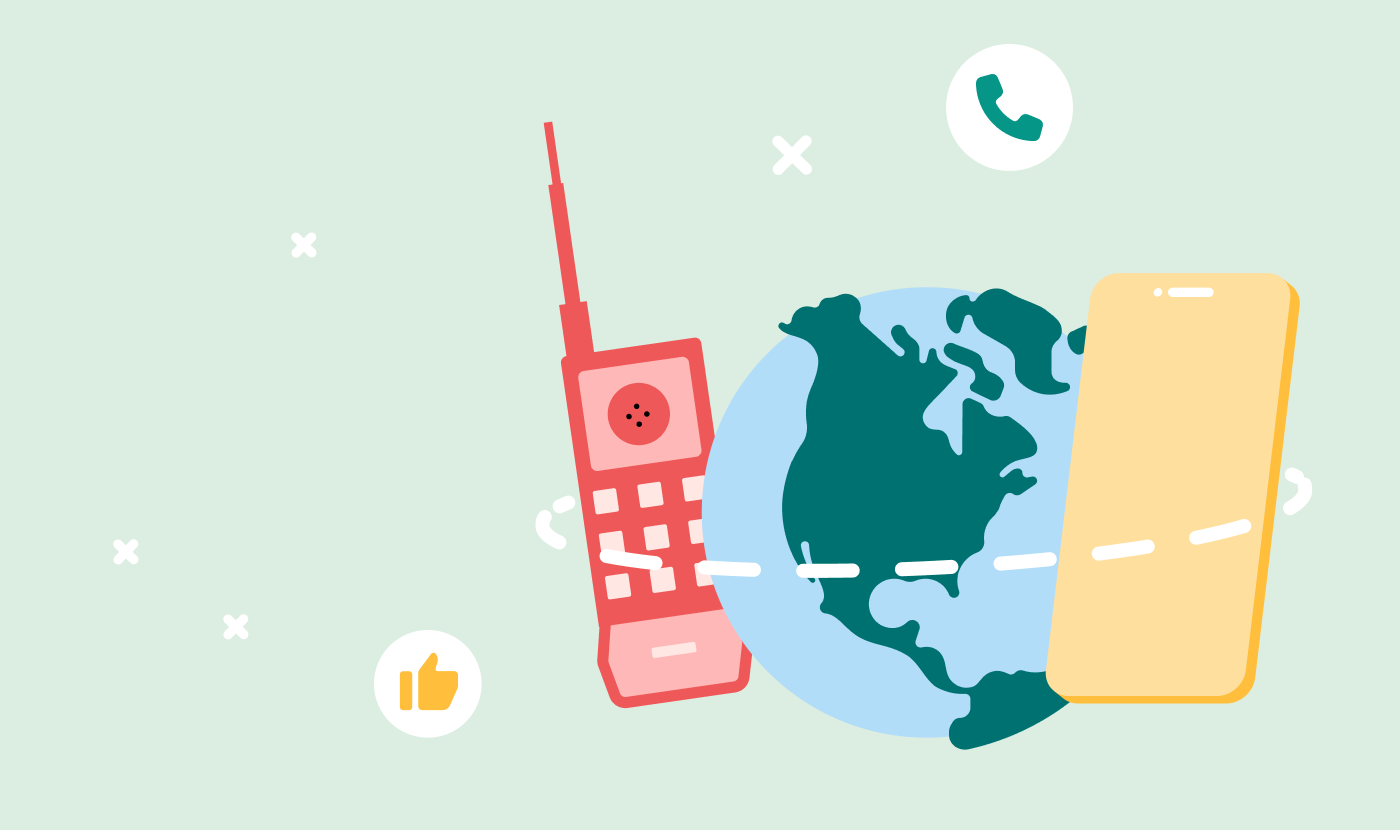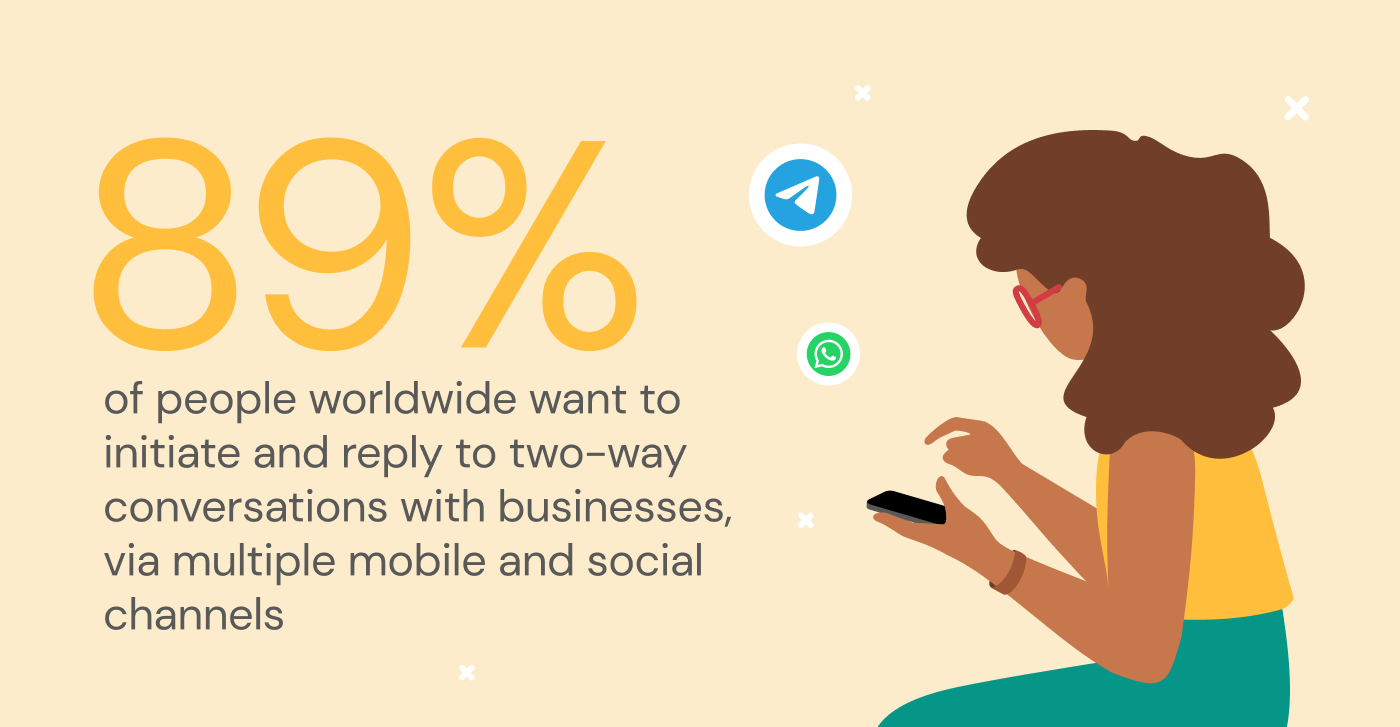Insights
The first mobile phone call turns 50: From calls to conversations and commerce

Insights

April 3, 1973 — American engineer Martin Cooper places the first mobile phone call in downtown New York.
Although real mobility wasn’t achieved until the 1980’s, this first mobile phone call paved the way for modern connectivity as we know it and forever changed the way humans and businesses communicate.
Over the last 50 years, mobile channels have evolved from voice calls to SMS, emails, messaging, social apps, and even chatbots, but also from one-way notifications to two-way conversations — we sum it up all up in this infographic.
To the consumer, it appears simple: Brands should be ready to engage on every channel. But for businesses, managing the complexity of communication channels and meeting consumers’ omnichannel expectations remains a complex challenge.
“I’m ringing you just to see if my call sounds good.”
Fifty years ago, Martin Cooper, a Motorola engineer, made history by making the first mobile phone call to his rival Joel Engel at Bell Lab, showing off the revolutionary technology he’d developed.
The device Cooper used was the Motorola DynaTAC. It weighed a whopping 2.5 pounds, was 10 inches long, and took a good 10 hours to charge. It also had a talk limit of just 35 minutes. Its price? $4,000 (more than $27,000 in today’s dollars).
Despite its limitations, Motorola’s first cell phone was breakthrough technology and the first-ever device to free people from landlines.
In a 2000 interview, Cooper predicted that “cellular was the forerunner to true wireless communications.”
“And just as people got used to taking phones with them everywhere, the way people use the Internet is ultimately going to be wireless. With our technology, you will be able to open your notebook anywhere and log on to the Internet at a very high speed with relatively low cost. At the moment, our story is about what a relatively small company is doing with high-tech stuff in Silicon Valley,” he said.
“But when people get used to logging on anywhere, well, that’s going to be a revolution.”
Today, Cooper’s prediction is proving truer than anyone could ever have imagined.
Mobile voice communications, once only accessible to the lucky few, are now a major aspect of everyday life and Sinch is playing a crucial role in helping businesses across the world reap the benefits of mobile voice technology.
Backed by a global super network and 600+ direct operator connections, our technology reaches every single mobile phone on the planet via all tier 1, 2, and 3 carriers in the US. We power more than 140 million phone numbers in the U.S. and Canada and 300 billion minutes of use annually.
But people no longer use their mobiles only for making phone calls. Just like Cooper predicted, people now use them to browse websites, place and track online orders, seek customer support, book taxi rides, communicate with their banks, and more — over email, SMS, and an ever-increasing number of messaging apps.

Cooper’s first mobile phone call underscored the importance of two-way communications. Today, businesses large and small are reinventing their marketing, service delivery, and customer care communications from one-way mass blasts to personalized, two-way customer communications, and messaging channels are a major part of the equation.
Why? Because that’s where today’s customers are, and where meaningful connections happen — and also because mobile messages boast a jaw-dropping 98% open rate and 90% read rate within three minutes of receipt!
Messaging channels are personal by nature; customers use them to connect with friends and family. Therefore, they represent a golden opportunity for brands to drive more engagement and build deeper customer relationships — not by just sending one-way, static notifications, but rather, by inviting customers in for a conversation.
Recent Sinch research clearly shows how much today’s customers value messaging-based interactions:
But with so many communication channels available today, how can brands satisfy every individual customer’s needs and preferences?
About 16% of consumers say they prefer to communicate with businesses over phone calls, while 36% prefer SMS, and 32% prefer email. Not to mention some might prefer messaging apps like WhatsApp, Viber, or Facebook Messenger.
At Sinch we’re all about helping businesses solve the complexity of the omnichannel puzzle. We power meaningful conversations at scale across messaging, voice, and email, allowing brands to connect with their customers at every step of their journey, no matter the channels they use.
In 2022, we enabled over 700 billion engagements via messaging, voice, and email.
By bringing communication channels together, we help businesses create, manage, and scale the ecosystem they need to develop today’s and tomorrow’s customer experiences.
With increasingly blurry lines between real life and conversational channels, conversational commerce is a natural next step for companies looking to meet customers on their own terms.
Think about it. Customers are already messaging brands to ask questions about the products they’re interested in. Why make them leave their text or messaging app to complete their purchases?
Ready or not, conversational commerce is the next big thing, and that’s not just our interpretation — it’s backed by research:
A conversational commerce revolution is under way, and the world’s biggest brands are taking notice:
From Cooper’s first mobile phone call, a communications revolution was born, forever changing the way people and businesses communicate, and spawning a vast, global, and complex mobile ecosystem.
Today, Sinch powers billions of mobile phone calls, messages, and emails, helping businesses meet customers how and where they want to engage, support, and eventually, convert them.
As a customer communications leader, we’re constantly evolving our technology, fueling the development of transformative customer experiences. Our main ambition and purpose, however, remain the same: helping businesses connect with their customers and reach their communications goals, whatever they may be.
But we wouldn’t be where we are today without Cooper’s contribution to the mobile communications industry. So here’s to Martin Cooper, to innovators and disruptors, and to meaningful connections!